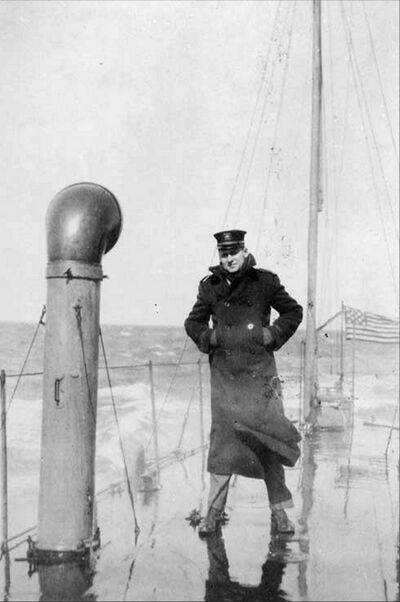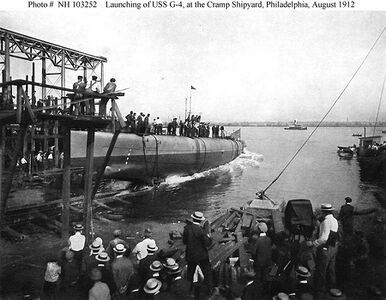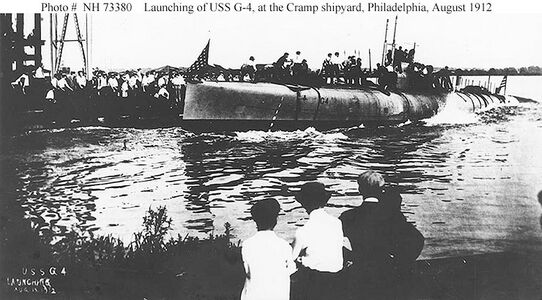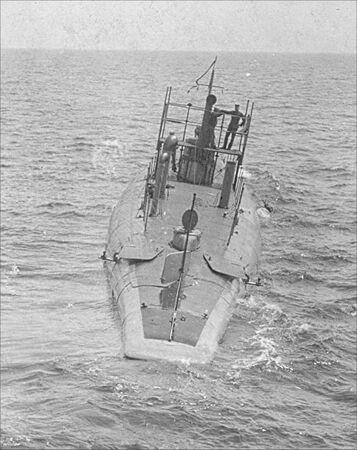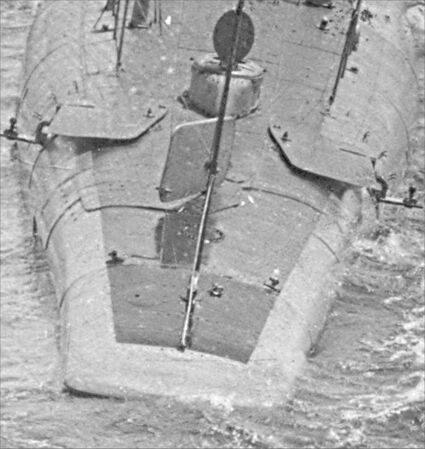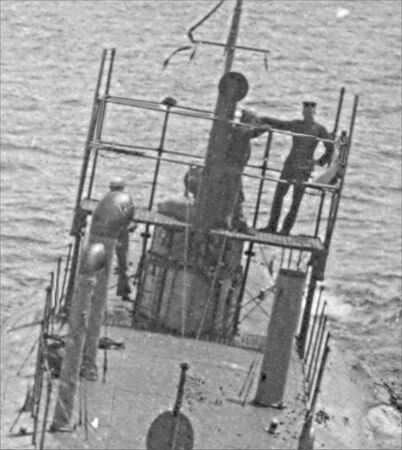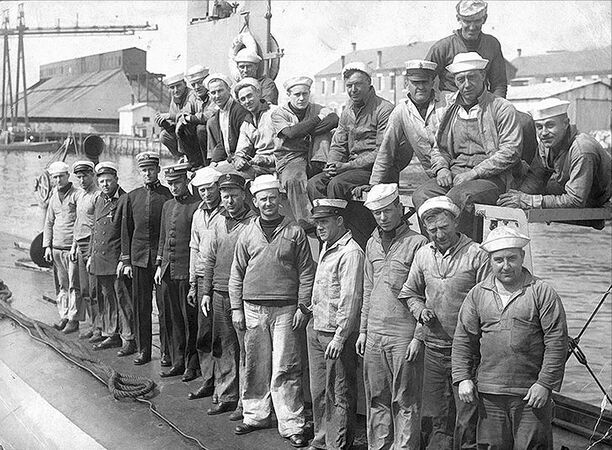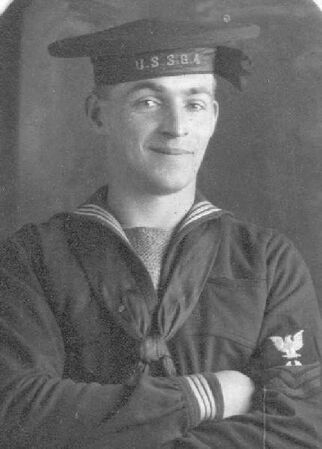G-4: Difference between revisions
Pbcjohnston (talk | contribs) Reformatting G-4 page |
Pbcjohnston (talk | contribs) Reformatting G-4 page |
||
| Line 6: | Line 6: | ||
File:G4-g4launch31-05.jpg|<div style="text-align: justify;"><span style="color:#00008B">This photo was taken a few seconds after the one on the left. The stern has become buoyant and is lifting off the launch cradle. She is starting to lean to port. Photo NH 73380 courtesy of NHHC.</span> | File:G4-g4launch31-05.jpg|<div style="text-align: justify;"><span style="color:#00008B">This photo was taken a few seconds after the one on the left. The stern has become buoyant and is lifting off the launch cradle. She is starting to lean to port. Photo NH 73380 courtesy of NHHC.</span> | ||
File:G4-g4launch32-06.jpg|<div style="text-align: justify;"><span style="color:#00008B">Now with only her bow on the launch cradle, G-4 lists heavily to port. The yard workers topside are scrambling to the starboard side in an attempt to stay aboard. A near disaster was averted and to our knowledge no one went over the side. National Archives photo.</span> | File:G4-g4launch32-06.jpg|<div style="text-align: justify;"><span style="color:#00008B">Now with only her bow on the launch cradle, G-4 lists heavily to port. The yard workers topside are scrambling to the starboard side in an attempt to stay aboard. A near disaster was averted and to our knowledge no one went over the side. National Archives photo.</span> | ||
</gallery> | </gallery><br><br> | ||
[[File:G4-g4top-07.jpg|left|thumb|National Archives photo.]] | |||
<div style="text-align: justify;"><span style="color:#00008B">G-4 at the Cramp yard during her 'fitting out' period, fall of 1912. This is a good overhead view of some of her more unusual features. The bow planes lay flat on the fore deck. They fold out and down and lock on to an axle that then rotates the planes to dive and rise positions. Although hard to see at the stern, the stern planes operate like the bow planes and are partly extended. The port plane can be seen as a square shape just forward of the 'doghouse' on the stern. The starboard plane is actually seen edge on, but its reflection can be seen in the water and you can se its square shape there. In the fully extended position both sets of planes would be flat to the water. Cramp yard slipways can be seen in the background.</span><br><br><br><br><br><br><br><br> | |||
[[File:G4-g4top-07.jpg| | [[File:G-4_fittingout.jpg|left|thumb|Photo NH 43799 courtesy of the Naval History & Heritage Command]] | ||
<div style="text-align: justify;"><span style="color:#00008B">G-4, seen on October 2, 1912, at the Cramp yard going through her 'fitting out' period where she will receive a majority of her piping, electrical and internal systems and habitability features. On the right near the bow the anchor hawsepipe can be seen, with an anchor chain running aft into an enclosed locker. This locker housed the anchor itself, attached to a "billboard" style release mechanism. The locker doors had to be opened to release the anchor. Billboard style anchor mounts were common on surface ships of this time, but very unusual on submarines.</span><br><br><br><br><br><br><br><br><br><br><br><br> | |||
<gallery mode=packed widths=400 heights=300> | |||
File:G4-g4atsea-11.jpg|<div style="text-align: justify;"><span style="color:#00008B">G-4 at sea prior to WW I, approximately 1914. The position of the upper rudder says that the submarine is making a left turn, and this could explain the starboard list. Photo from the Rick Larson Collection, now in the private collection of Ric Hedman.</span> | |||
File:G4-g4atsea2-12.jpg|<div style="text-align: justify;"><span style="color:#00008B">Closeup of the stern, showing details of the topside rudder, folded up stern planes, and the open aft torpedo room hatch.</span> | |||
File:G4-g4atsea3-13.jpg|<div style="text-align: justify;"><span style="color:#00008B">Closeup of the conning tower fairwater and bridge structure. The commissioning pennant is flying from the radio mast. The officer on the right is most likely the boat's Commanding Officer, LT Ernest D. McWhorter.</span> | |||
</gallery><br><br> | |||
[[File:G4-g4atsea-09.jpg|left|thumb|National Archives photo.]] | |||
<div style="text-align: justify;"><span style="color:#00008B">G-4 at sea, most likely pre-WW I, circa 1914-15. Note the Allied signal bell on the fore deck aft of the hatch and the upper rudder all the way to the right, behind the two men.</span><br><br><br><br><br><br><br> | |||
[[File:G4-g4atsea2-10.jpg|left|thumb|National Archives photo.]] | |||
<div style="text-align: justify;"><span style="color:#00008B">G-4 at sea, burying her bow in a head sea, most likely pre-WW I, circa 1914-15. The upper rudder can be clearly seen in this photo.</span><br><br><br><br><br><br><br><br><br><br><br><br> | |||
<gallery mode=packed widths=400 heights=300> | <gallery mode=packed widths=400 heights=300> | ||
File:G4-g4crew1917-14.jpg|Ship's officers and crew posed on deck, 1917. She was then operating out of the U.S. Naval Submarine Base, New London, at Groton, Connecticut. The two officers (4th & 5th from left, front row) are Lieutenant (Junior Grade) Paul F. Foster (Commanding Officer) and Lieutenant (Junior Grade) William F. Callaway (Executive Officer). | File:G4-g4crew1917-14.jpg|Ship's officers and crew posed on deck, 1917. She was then operating out of the U.S. Naval Submarine Base, New London, at Groton, Connecticut. The two officers (4th & 5th from left, front row) are Lieutenant (Junior Grade) Paul F. Foster (Commanding Officer) and Lieutenant (Junior Grade) William F. Callaway (Executive Officer). | ||
| Line 27: | Line 28: | ||
</gallery> | </gallery> | ||
---- | ---- | ||
---- | ---- | ||
[[File:Crew-enspaulwfoster-001.jpg|thumb|400px|Ensign Paul F. Foster, USN Photographed circa 1914. Foster was awarded the Medal of Honor for his actions at Vera Cruz, Mexico, on 21-22 April 1914.]] | [[File:Crew-enspaulwfoster-001.jpg|thumb|400px|Ensign Paul F. Foster, USN Photographed circa 1914. Foster was awarded the Medal of Honor for his actions at Vera Cruz, Mexico, on 21-22 April 1914.]] | ||
Revision as of 15:31, 5 May 2023

-
G-4 sliding down the ways at the Cramp yard, August 15, 1912. The strange looking bulge seen on the under-body of the bow just to the right of the diagonal brace is the port torpedo tube. Photo NH 103252 courtesy NHHC
-
This photo was taken a few seconds after the one on the left. The stern has become buoyant and is lifting off the launch cradle. She is starting to lean to port. Photo NH 73380 courtesy of NHHC.
-
Now with only her bow on the launch cradle, G-4 lists heavily to port. The yard workers topside are scrambling to the starboard side in an attempt to stay aboard. A near disaster was averted and to our knowledge no one went over the side. National Archives photo.
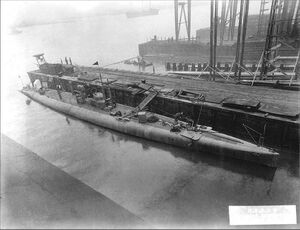
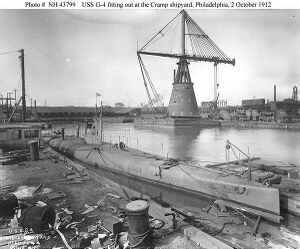
-
G-4 at sea prior to WW I, approximately 1914. The position of the upper rudder says that the submarine is making a left turn, and this could explain the starboard list. Photo from the Rick Larson Collection, now in the private collection of Ric Hedman.
-
Closeup of the stern, showing details of the topside rudder, folded up stern planes, and the open aft torpedo room hatch.
-
Closeup of the conning tower fairwater and bridge structure. The commissioning pennant is flying from the radio mast. The officer on the right is most likely the boat's Commanding Officer, LT Ernest D. McWhorter.

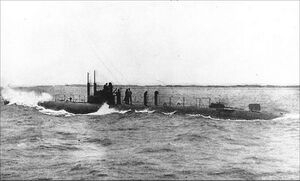
-
Ship's officers and crew posed on deck, 1917. She was then operating out of the U.S. Naval Submarine Base, New London, at Groton, Connecticut. The two officers (4th & 5th from left, front row) are Lieutenant (Junior Grade) Paul F. Foster (Commanding Officer) and Lieutenant (Junior Grade) William F. Callaway (Executive Officer).
-
A few of the workmen from the Cramp Ship Yard that built the USS G-4. Seen are yard officials, shop and department supervisors and the craftsmen who were putting the G-4 together. Commissioning was still 14 months away.
-
Unknown sailor off the USS G-4. Time unknown. He appears to be a MM or MoMM/1c.
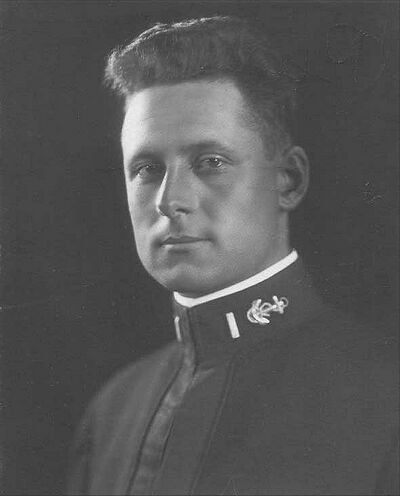
Paul Frederick Foster was born on March 25, 1889 in Wichita, Kansas. He received a senatorial appointment from the State of Idaho to the U.S. Naval Academy. Following graduation in 1911, he served in the armored cruiser Washington and the battleship Utah as a midshipman and, in March 1912, was commissioned as an Ensign. On 21-22 April 1914, Foster participated at the intervention at Vera Cruz, Mexico, leading his landing company with skill and courage. For his "distinguished conduct in battle", he was awarded the Medal of Honor.
After submarine instruction on board USS Prairie, he reported on board USS G-4. In March 1915, Foster was promoted to Lieutenant Junior Grade and, in early 1916, was placed in command of G-4.
Relocating to Ireland in December 1917, he was assigned to the submarine tender Bushnell in Bantry Bay, Ireland. Foster was temporarily promoted to Lieutenant in May 1918. While serving in Irish waters, he took command of the submarine L-2. Lieutenant Foster was awarded the Distinguished Service Medal for his role in the sinking of the German submarine UB-65 off the Irish coast on 10 July 1918.
